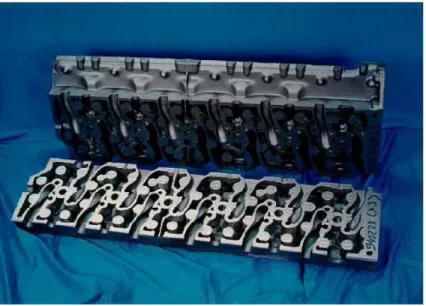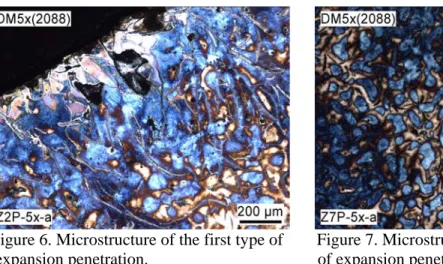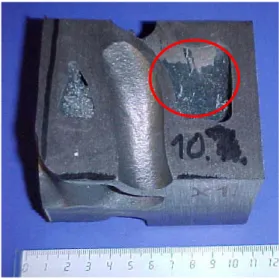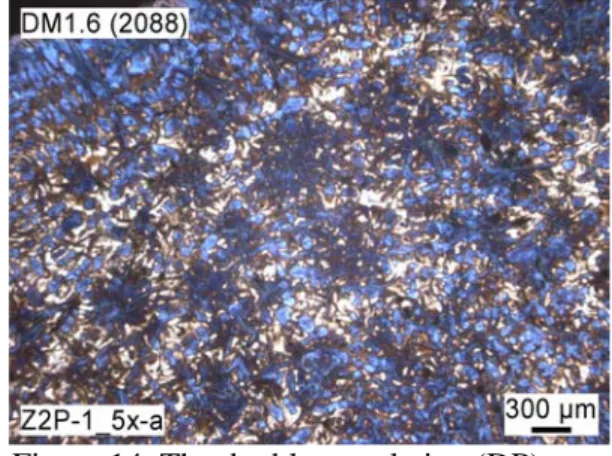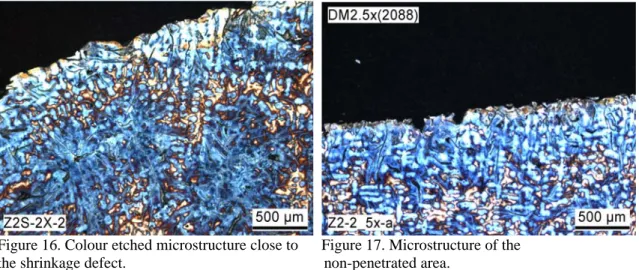Metal Expansion Penetration on Concave Casting
Surfaces of Grey Cast Iron Cylinder Heads
Izudin Dugic, Attila Diószegi and Ingvar L Svensson
Research report 2006:1, ISSN 1404-0018
Jönköping University
Dept of Mechanical Engineering/Component Technology P.O. Box 1026
SE.-551 11 Jönköping Sweden
Metal Expansion Penetration on Concave Casting
Surfaces of Grey Cast Iron Cylinder Heads
Abstract
Cylinder heads have an extremely complex shape with large areas of concave casting surfaces. The concave casting surfaces are often associated with metal expansion penetration problems or other surface defects, e. g. surface shrinkage. The defects cause high production costs due to component rejection and increased fettling time. This report presents an investigation of the microstructure in grey cast iron close to the sand-metal interface affected by metal penetration in a complex shaped casting. The dominant penetration defect observed in the cylinder heads was expansion penetration. Even pre-solidification penetration and sand crack defects were observed. The microstructure found in the non penetrated areas is typical for solidification of grey iron cast in sand moulds.
Keywords: Grey iron, cylinder head, primary austenite, hot spot, metal expansion penetration, surface
shrinkage, dendrite, inoculation.
Metal penetration is one of the most important factors affecting the surface finish of cast components in the iron foundry industry. Metal penetration often incurs extra fettling costs, and in severe cases leads to scrapping of castings. The extra fettling times and costs vary considerably from foundry to foundry, and with the severity of the defect and the type of casting produced.
The general definition of metal penetration accepted by the foundry industry, as proposed by Draper and Gaindhar1 is the condition in which cast metal has entered into the pore spaces of the mould and core beyond the mid-point of the surface layer of sand grains.
During eutectic solidification, cast iron solidifying with an austenite–graphite eutectic structure has been demonstrated to expand significantly. The expanding metal exerts a considerable pressure on the mould walls. If the mould is rigid, and if the metal cannot be pushed back in the riser or the gates because they have solidified, the pressure results in metal penetration, called expansion penetration, into the mould. This type of penetration was first identified by Levelink and Julien2 who called it exudation penetration. They indicated that the expansion occurring during eutectic solidification may result in exudation of eutectic in locations where a solidifying metal shell does not obstruct it. This is especially so at “hot spots”, such as in the corners of “L”, “T” and “Y” sections, where the metal is still liquid at the time expansion occurs due to eutectic solidification. The expansion penetration depends upon the metallurgical characteristics of the solidifying metals and alloys. Expansion penetration is most common when the CE (carbon equivalent) is high. This has been reported by Levelink and Julien2 and confirmed in an earlier workby the authors3.
In the work mentioned above an abnormal eutectic cell structure was found in the neighbourhood of penetrated areas. Two different populations of eutectic cell sizes were found to be present. Between a larger population of eutectic cells, a smaller population was identified which indicated that the different populations nucleated at different times during solidification. The mechanism of nucleation for the double eutectic cell population is not understood but it was characteristic for the penetrated areas.
The theory of exudation or metal expansion penetration proposed by Levelink and Julien was developed further. Diószegi at el4 suggested a new description for the metal penetration mechanisms, considering the nucleation and growth of both the primary austenite grains and the eutectic cells. According to these descriptions there are two different metal expansion penetration mechanisms. The first type occurs before the columnar to equiaxed transition of the primary austenite grains, whereas the second type occurred after the columnar to equaixed transition. A transition between the two mechanisms was also found. Typical for the first type of penetration mechanism was the exudation of a perfect eutectic phase from the interdendritic area to the mould surface, while in the second type of penetration mechanism an anomalous phase from the eutectic cell border was pushed to the mould interface, simultaneously with the deformation of the cast surface. These observations were made both by Levelink and Julien and by Diószegi et. el. on cylindrical test cups with different shapes of the mould surface exposed to penetration.
The aim of this paper is to present the extended work on evaluation of the microstructures in a complex shaped cylinder head cast in grey cast iron with respect to metal expansion penetration and to compare the observations with those made by Diószegi at el on the metal-mould interfaces of the experimental test cups. The investigation of the cylinder head casting was carried out as part of a research project in collaboration between the University of
Jönköping, Division of Component Technology and the Skövde Foundry of Volvo Truck Component Corporation.
EXAMINATION OF CYLINDER HEADS
The cylinder heads studied were prepared on a standard moulding line using green sand as moulding material. The cores containing quartz sand were bound by an organic binder using SO2-gas as catalyst. The geometry of the cylinder head is considered to be a complex shaped part, as shown in figure 1.
Figure 1. A sectioned cylinder head.
The moulds were poured from a 1.5 ton ladle, after inoculation in the ladle with a standard inoculant containing strontium. The chemical composition of the inoculant is shown in table 1. The amount of the inoculant added was 0.15 wt%.
Table 1. Chemical composition of the inoculant.
Wt % Si Wt % Ca Wt % Al Wt % Sr
73 – 78 max 0.1 max 0.5 0.6 – 1.0
The melt was a grey iron with the chemical composition shown in table 2. Table 2. Chemical composition on the alloy (weight %)
C Si Mn S P Cr Ni Mo
3.30 1.85 0.63 0.09 0.03 0.12 0.04 0.20
After blasting the cylinder heads were investigated by an ocular inspection. The specimens for study were cut out from the areas where metal penetration had occurred. Some of these specimens are shown in figures 2 and 3. The penetration area is indicated by red circles.
Figure 2. The investigated specimens Figure 3. The investigated specimens showing metal expansion penetration. showing metal expansion penetration.
The specimens were ground and polished in order to investigate the graphite morphology by optical microscopy. After a first inspection the specimens were the etched in a picric acid-based reagent at 110 ºC in order to investigate the primary austenite and the eutectic cells.
DISCUSSION
The extremely complex shaped cylinder heads showed different types of penetration related defects. The colour etching technique used allows the defects to be classified with respect to the mechanisms of defect formation. The defects observed are discussed below in chronological order with respect to the mould filling and solidification of the different phases.
PRE-SOLIDIFICATION PENETRATION
A minor group of penetration defects were identified as metal particles which had penetrated between sand grains (Figure 4). The microstructures clearly reveal that the particles solidified with a coarse primary austenite phase surrounded by an austenite – graphite eutectic phase. This type of penetration is classified as pre-solidification penetration. The presence of all phases indicate that the metal droplet has the same chemical composition as the original melt, and was forced to penetrate between the sand grains before solidification started. This type of penetration is believed to result from the conservation of momentum at the end of mould filling.
Figure 4. Microstructure of the penetrated Figure 5. Microstructure of the penetrated area. area.
METAL EXPANSION PENETRATION
The predominant number of penetration events observed in the cylinder heads were due to metal expansion penetration. The microstructure of particles which had penetrated between the sand grains showed an exclusively eutectic composition (Figure 5). The casting surfaces in connection to the penetrated particles with the eutectic phase consisted of a eutectic strip with graphite lamellas oriented mainly perpendicularly to the mould surface (Figures 6 and 7). This combination of microstructure in the penetrated particles and the casting surface is identical to that observed by Diószegi at al4. Metal penetration was found to occur during the early part of the solidification process, before the columnar to equiaxed transition, and before the eutectic phase is squeezed through the primary austenite network of the outer columnar austenite grains to the mould surface.
Figure 6. Microstructure of the first type of Figure 7. Microstructure of the first type expansion penetration. of expansion penetration.
Behind the penetrated particles of eutectic composition there was observed a second type of microstructure in connection to the mould surfaces. This type of microstructure indicates a normal fraction of primary phase behind the casting surface (Figure 8) and much less dense primary phase in connection to the casting surface (Figure 9). The normal fraction of primary phases is determined by the chemical composition.
Figure 8. Microstructure at the metal-mould Figure 9. Microstructure behind the abnormal interface with sparse fraction primary phase structure presented in figure 8. The fraction austenite and an anomalous interdendritic primary austenite is in good correlation to the phase. chemical composition, and the graphite morphology is type A.
CRACKS IN THE CORE
The microstructure investigations of the metal expansion penetration close to the sand cracks (Figure 10) show two different type of microstructure. The first type of microstructure is found when metal filled the crack in the core, and consists of white solidified iron, Figure 11. This type of crack in core is assumed to happen very early during the mould filling when thermal shocks are believed to contribute to the sand crack formation. The completely white solidification of the metal in the crack indicates a very quick solidification.
The second type of microstructure occurs when core cracks are connected with metal penetration between the sand grains, and is shown in Figure 12. The metallic particles between the sand grains and the bridge connecting the penetration area to the casting surface contain exclusively a eutectic phase. This indicates that the moment of penetration is at a late stage of solidification, when only the eutectic phase can exist. In contrast to the case when thermal shock leads to distortion of the core surface, in the latter case the core is already heated, and it is probable that the grain boundaries are weakened and crack formation is caused by distortion of the outer austenite shell.
Figure 10. The specimens showing cracks in the core.
Figure 11. Microstructure of the Figure 12. Microstructure of the penetrated area. penetrated area.
DOUBLE EUTECTIC POPULATION
A double population of eutectic cells was found (as shown in Figures 13 and 14) close to the penetrated areas, but in some case it also occurred in non-penetrated areas. It is difficult to clearly understand the relationship of this phenomenon with penetration in these castings.
Figure 13. The double population (DP) Figure 14. The double population (DP) of eutectic cells. of eutectic cells.
NON-PENETRATED AREAS VS. SURFACE SHRINKAGE
Convex core surfaces associated with penetration problems are sometimes also affected by surface shrinkage. Figure 15 shows examples of surface shrinkage found in the cylinder head. The microstructure behind the surface shrinkage shown in Figure 16 is compared to the microstructure of concave metal surfaces where penetration was not found, in Figure 17. It is difficult to see any differences. Both microstructures appear to be normal with respect to similar casting structures of comparable chemical composition and cooling conditions.
Figure 15. The specimens showing surface defect shrinkage.
Figure 16. Colour etched microstructure close to Figure 17. Microstructure of the the shrinkage defect. non-penetrated area.
CONCLUSIONS
Cylinder heads typically have an extremely complex shape, with large areas of concave casting surfaces which are prone to surface defects. Investigations made on cylinder heads cast under industrial production conditions reveal the same modes of expansion penetration as have been found to occur in experimental test cups cast at the same foundry and under the same metallurgical conditions. Metal expansion penetration which is deduced to occur before and after the columnar to equiaxed transition is observed to predominate. Pre-solidification penetration and sand crack defects were also observed. The microstructures below the surface shrinkage appear to be identical with microstructures of concave casting surfaces not affected by penetration.
The frequency of penetration defects observed shows the expansion penetration as being the dominant surface defect. Only a minority of penetration defects found can be traced to phenomena prior the solidification event.
For measures to prevent penetration defects the authors would like to recommend close metallurgical control of the melting process, including adequate control of nucleation and solidification.
ACKNOWLEDGMENTS
The authors would like to thank the partner of this research project, namely the Skövde Foundry of Volvo Truck Component Corporation.
REFERENCES
1. A.B. Draper and J.I. Gaindhar, “Metal Penetration – A Critical Review”, AFS Transactions, 85 (1977). 163-199.
2. H.G. Levelink and F.P.M.A. Julien, “Penetration and shrinkage by interaction of solidifying cast iron and casting mould–Part 2”, AFS Cast Metals Research Journal, 9(2) (1973) 105-109.
3. I. Dugic and I.L. Svensson, The effect of chemical composition on the metal expansion penetration in grey cast iron, Research report 99:1, ISSN 1404-0018, (1999), Division of Component Technology, The School of Engineering, Jönköping University, Sweden.
4. A. Dioszégi and I. Dugic, “The Mechanisms of Metal Expansion Penetration in Grey Cast Iron”, Conference Proceeding ISCP8, Beijing, October 2006.
